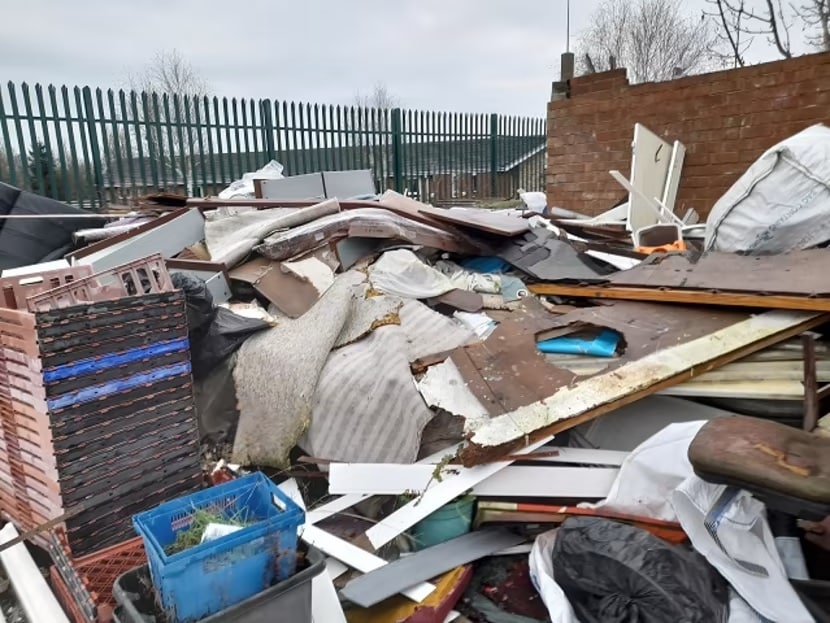Why is asbestos construction waste management important?
All businesses produce some degree of waste, but firms that are involved in construction and demolition unquestionably create a particularly high amount of waste during the course their operations. As a consequence, such organisations need to know how they can manage this waste in a manner that complies with their legal and moral obligations, while helping to ensure safety.
The term “construction waste” applies to any material or matter that is produced as a consequence of any form of construction and/or demolition work, and that is subsequently discarded. Such materials as concrete, bricks, and stone can be contained within construction waste, which routinely arises from such processes as excavation, renovation, site clearance, and roadworks.
The term “construction waste management”, then, refers to the practices involved in managing these materials. One reason why construction waste management is so important, is the potential for some common construction waste materials – such as asbestos – to be hazardous to human health.
There are various pieces of legislation in the UK that require construction businesses to take great care in how they handle and dispose of construction waste. These include the likes of the Waste (England and Wales) Regulations 2011, the Hazardous Waste (England and Wales) Regulations 2005, and the Environmental Protection Act 1990.
However, with asbestos having been so widely used in UK construction during the 20th century prior to the 1999 ban on its use, it is a substance that poses particularly high demands when it comes to responsible waste management. Below, then, we have taken a closer look at construction waste management in the context of asbestos-containing materials (ACMs).

Why is there asbestos in construction waste?
The importation and use of asbestos in the UK was banned in 1999 because by that point, the serious health risks the material posed had become very well-known.
When someone breathes in or ingests loose asbestos fibres, they can be at elevated risk of developing a potentially fatal asbestos-related disease, such as mesothelioma or asbestos-related lung cancer. These health conditions can have an extremely long latency period, meaning they may only become apparent to the sufferer several decades after the incident of asbestos exposure. By then, it is often too late for treatment to have much effect on the long-term health outcome.
So, it is of the utmost importance to guard against incidents of asbestos exposure happening at all. Unfortunately, back when asbestos was widely used in UK construction for the bulk of the 20th century, it was routinely mixed with other materials. This, combined with the fact that individual asbestos fibres are barely discernible to the human eye, can make ACMs extremely difficult to spot, even on asbestos-contaminated sites.
Unfortunately, in decades past, UK law on both asbestos management and waste disposal was much less stringent than it is now. With asbestos products that were formerly used in the construction of UK buildings including the likes of lagging, roofing felt, asbestos insulating board, and composites, poor housekeeping practices – or buildings simply being demolished with ACMs still inside – could easily lead to the contamination of such sites with asbestos fibres.
Today, much stricter legal requirements exist with regard to the management of asbestos waste. In England and Wales, asbestos waste is classified as “Hazardous Waste” if more than 0.1% asbestos is present. If this is the case for construction waste that your business needs to manage, you will need to comply with the Hazardous Waste Regulations 2005, and complete a Hazardous Waste Consignment Note.
What is the importance of construction waste management for asbestos?
In light of the very serious risks that asbestos can pose to human health, it is of the utmost importance to not treat asbestos like “just any other waste”. If you are looking to dispose of asbestos sheeting, for example, you must not simply throw it over a standard skip or bring it to a standard local recycling centre.
When asbestos waste is not managed and disposed of in a safe and legally compliant way, this can bring about wide-ranging issues. The demolition of a building containing ACMs, for example, can leave loose asbestos fibres in the soil, while other asbestos dust can linger in the air for a long time, posing risks to the health of humans and even animals.
Improperly managed asbestos waste can also lead to fibres entering rivers, lakes, and groundwater, with the resultant contamination potentially causing harm to aquatic life and negatively affecting the quality of drinking water. In these ways, asbestos contamination can present serious problems to the environment, beyond the immediate risk of humans breathing in freshly released asbestos fibres.
Bear in mind, too, the major legal and financial implications that can arise due to any breaches of the UK asbestos regulations, including in relation to the management of asbestos waste from a construction site. As we have previously written about, serious breaches of asbestos regulations can lead to an unlimited fine and/or imprisonment for up to two years.
What are the health and safety considerations?
Around 5,000 asbestos-related deaths continue to occur each year in the UK, despite use of the material in UK construction having been banned more than two decades ago. This is partly due to the often decades-long latency period for such conditions as mesothelioma and asbestos-related lung cancer, but there is also no doubt that fresh incidents of asbestos exposure can, and do, happen.
The fact is, there is a critical moral, financial, and legal imperative to do everything possible to protect both workers and the public from harm caused by asbestos.
This is why, if you are legally responsible for a given site or building where there is a risk of construction waste containing asbestos, you must implement various safety and control measures. These include arranging for the asbestos surveying work and risk assessments that will enable you to determine whether ACMs are present, and the risks they could pose to health.
Once any given ACMs are ready for disposal, they can be classed as asbestos-containing waste (ACW). Asbestos waste is any waste that consists of more than 0.1% weight-for-weight (w/w) asbestos, although such items as contaminated building materials, tools that cannot be decontaminated, and personal protective equipment (PPE) are also included in this definition.
What are the best practices to follow in asbestos waste management?
It is of critical importance to follow all the accepted best practices for the safe collection, transportation, and disposal of asbestos waste.
Even the removal of given ACMs from a property (so, before the stage at which they actually become waste), will need to be carried out by someone who has been suitably trained, and who has the necessary equipment.
Specialised training will be needed, too, for anyone who intends to work with ACW. There are also various packaging requirements for asbestos waste, which must be packed in UN-approved packaging that incorporates a CDG hazard label and visible asbestos code information. The double-bagging, wrapping, and labelling of ACW are all critically important elements.
As for when the time comes to transport asbestos waste away from the site where it was removed, this must only be done by someone with a waste carrier’s licence. This licensed waste carrier must rapidly consign the ACW to a dump that is licensed to accept asbestos, although there are some exceptions to this when it is domestic or agricultural ACW that needs to be disposed of.
Furthermore, the waste carrier is required to use a sealed skip, or a vehicle with a segregated compartment for asbestos, that is also easy to clean and lockable.
What is the legal and regulatory framework to follow?
There are various pieces of legislation in the UK that apply to how asbestos waste is managed, removed, and/or disposed of. These include the likes of the Control of Asbestos Regulations (CAR 2012) and the Carriage of Dangerous Goods Regulations.
CAR 2012, for instance, is aimed at “dutyholders” for a given non-domestic building or site – in other words, those with responsibility for managing and arranging maintenance and/or repair at the premises. Regulation 24 of CAR 2012 stipulates that employers must ensure the correct packaging, labelling, storage, and transportation of raw asbestos and asbestos waste.
Meanwhile, the Carriage of Dangerous Goods Regulations incorporates requirements for packaging and documentation. Fibrous or unbonded asbestos waste that is categorised as a UN Class 9 substance, for example, will need to be properly packaged in UN certified packaging. Such material is typically required to be double bagged in red inner and clear outer polythene bags that are tested and certified.
What are the financial implications of asbestos waste management?
The asbestos waste management process can entail a wide range of costs, encompassing all the key steps of collection, transportation, and disposal, as well as the necessary efforts to ensure legal compliance across all these stages.
Both direct and indirect costs will need to be accounted for – examples of the former including equipment and disposal fees, while the latter can include potential healthcare for those who may be exposed to asbestos waste, as well as insurance premiums and environmental cleanup.
A crucial principle to remember here, is that while the “headline” price of managing asbestos waste in a safe and legally compliant manner might seem high, this is likely to pale in comparison to the long-term costs of not complying with your asbestos waste management responsibilities.
As we have covered elsewhere in this article and in our past pieces for the Oracle Solutions Learning Centre, any failures in your asbestos waste management as an individual or business can bring extremely serious and expensive consequences. These include legal penalties, as well as long-term liabilities in relation to those who may develop asbestos-related disease due to exposure to asbestos waste on a site for which you were responsible.
Ensuring you do have a comprehensive and fastidious system in place for the management of construction waste at your site – including ACW – is therefore simply a very good investment, as well as a moral obligation that you have to both workers and the general public.
Conclusion: making the right decisions on asbestos waste is vital for ensuring safety
Having the right systems and procedures in place for effective construction waste management in general, will also greatly aid you with your all-round asbestos management, including how you deal with asbestos waste. The two interconnected fields very much go hand in hand.
Today, the UK construction sector, waste management services, and regulatory bodies all have a strong collective responsibility to ensure the highest standards of efficient, safe, and legally compliant asbestos waste management.
Would you appreciate advice and guidance on how you can optimise your own practices in relation to asbestos waste management, including ensuring your adherence to the relevant regulations? If so, please don’t hesitate to enquire to the Oracle Solutions team today.

Written by Mark Carter
Mark Carter is a renowned expert in asbestos management, offering clients vital guidance on compliance and safety. His expertise is invaluable for navigating asbestos regulations, ensuring both safety and legal adherence. Mark's role is central in providing effective asbestos-related solutions, helping clients achieve their business objectives with an emphasis on regulatory compliance and safety in asbestos management.
